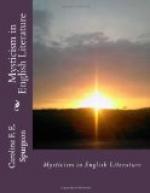The intensity and freshness of religious feeling of a mystical type in England in the twelfth, thirteenth, and fourteenth centuries are often not realised, partly owing to the fact that much of the religious writing of this time is still in manuscript. The country was full of devotees who had taken religious vows, which they fulfilled either in the many monasteries and convents, or often in single cells, as “hermit” or “anchoress.” Here they lived a life devoted to contemplation and prayer, and to the spiritual assistance of those who sought them out.
The hermits, of whom there were a large number, were apparently free to move from one neighbourhood to another, but the woman recluse, or “anchoress,” seldom or never left the walls of her cell, a little house of two or three rooms built generally against the church wall, so that one of her windows could open into the church, and another, veiled by a curtain, looked on to the outer world, where she held converse with and gave counsel to those who came to see her. Sometimes a little group of recluses lived together, like those three sisters of Dorsetshire for whom the Ancren Riwle was written, a treatise which gives us so many homely details of this type of life.
Richard Rolle (c. 1300-1349), of Hampole, near Doncaster, and the Lady Julian, a Benedictine nun of Norwich (1342-c.1413), are the two most interesting examples of the mediaeval recluse in England. Both seem to have had a singular charm of character and a purity of mystical devotion which has impressed itself on their writings. Richard Rolle, who entered upon a hermit’s life at nineteen on leaving Oxford, had great influence both through his life and work on the whole group of fourteenth-century religious writers, and so on the thought of mediaeval England. His contemporaries thought him mad, they jeered at him and abused him, but he went quietly on his way, preaching and writing. Love forced him to write; love, he said, gave him wisdom and subtlety, and he preached a religion of love. Indeed the whole of his work is a symphony of feeling, a song




